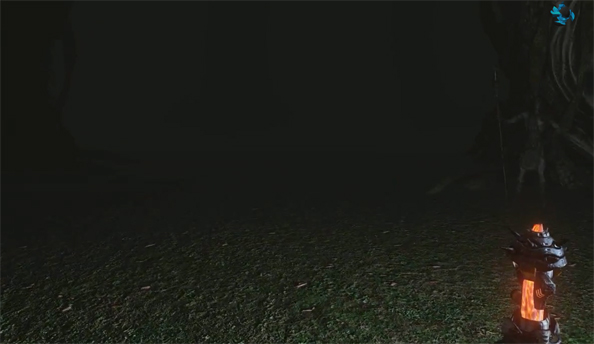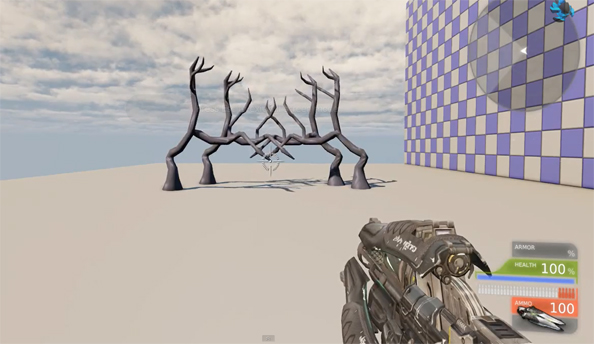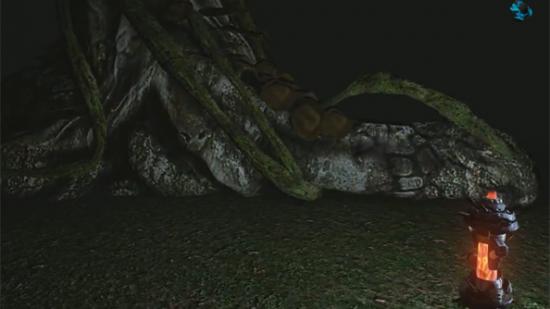This is Game 101: between now and May, PCGamesN will be engaging in a kind of vicarious immersion therapy – looking through the eyes of five teams of Staffordshire university students as they make, break, fix and, finally, finish their first game. Or rather, games – five of ‘em, each based on a story from Grimms’ 19th century German fairy tales. Today, we’re looking at a first-person horror take on Hansel and Gretel, which exists in my notes only as ‘the Fog one’.
Before Christmas, game designer Alec Dilkes and his student team at Staffordshire uni had a studio name: Crimson Pixel. But that was about all they had, aside from an edict that required them to build a game based on one of Grimm’s Fairy Tales in Epic’s UDK engine by May, and a suspicion that Tom Thumb might make a good subject for an action-adventure.
One day, though, Dilkes was browsing the Grimms’ finest for a backup pitch and happened upon the most famous of them all: Hansel and Gretel. Knowing that the team would need as much room to iterate as possible in the coming months, he realised that the witch’s forest was, paradoxically enough, a surefire way to avoid being caged in by peculiar plot constraints later in development.
“The fact that you can have the forest allowed for so much tweaking, improving and changing,” said Dilkes. “It could be whatever we wanted it to be. It didn’t even have to be horror, it could be an adventure.”
In the event, Hansel is a horror game – one that sees Crimson Pixel twist the Grimms’ latently awful child abandonment tale to more overtly horrific ends. But no tree limb-chopping Dead Space clone this – the adapted Hansel is a game that bears closer resemblance to Amnesia or Steam Greenlight favourite Faceless than any big-studio title.
Since the early tech demo above – which saw protagonist Hansel lumbered with a breadcrumb-dropping mechanic – Crimson Pixel have rearranged their myth to fit a clearer search-and-rescue structure. In the new Hansel, Gretel has fallen into the clutches of the cake-housed witch, and it falls to her brother to follow her crumb-trail – now a simple pathfinding aid – through a hostile forest.
Players will chase the crumbs down a more-or-less linear path to the finish line in each level. Bread-bits will be rare enough that players are relieved to discover that they’re going the right way, but not so well-spaced that they might take a ten-minute wander off-piste without noticing that something’s up.
Nevertheless, Dilkes deems it “crucial” that players are able to get lost, all the while keeping one jittery eye on an ever-present oil lamp. The light keeps monsters, seen and unseen, from entering the player’s radius, and the result will be a kind of perpetual version of that action-adventure staple – the underwater bubble-collection sequence. Oil collected at the end of a dead-end might keep the lights on, but for how much longer?
Whether or not oil could be preserved by temporarily turning the lamp off was the subject of a four-hour discussion, but the student team eventually decided that the mechanic would be too easily exploited.
“The lamp basically creates a forcefield, a barrier,” explained Dilke. “So if there’s an enemy close, you might just click it on and off, on and off. Because we don’t have the best coders, it might glitch out.”

The fixed lamp helps foster a sense of helplessness through mechanical limitation the game has gleaned from ‘90s horror games like Resident Evil. In Hansel, the player is unable to jump, crouch to hide from enemies, or break into anything more strenuous than a brisk walk.
“In a forest, if anything the enemies are going to be hiding from you until the lamp goes out,” said Dilkes. “You’ve got a big lamp and you’re going to be attracting attention. You’re just trying to get through it.”
Other ideas still to be iterated on include bear traps, sludge enemy types equipped to dim the player’s lamp, and enchanted trees who’ll wrap players in their twiggy embrace, temporarily halting progress.
The trees will take a central role in keeping the forest hostile, opening and closing pathways at key points during the game’s four levels. In fact, in initial discussions Crimson Pixel had planned to shift their environments fundamentally twice a minute.
Dilkes explains: “The idea at the start was, every 30 seconds the entire environment would shift. All of the trees would move, some would open and some would close, and new paths would open. I thought this was a great idea, until I realised how much processing power it would take, how many trigger sequences we would have to initiate at once, and how hard it would be to keep it reoccurring every time. So we’re being more realistic.”

Crimson Pixel demo their shifting environments in UDK.
Now, the changing environments will see escape routes opened Zelda-style using key items, or ask will the player to make life-or-death decisions: “We’re basically saying, ‘Look, you can go this way now. Do you want to risk it?’”, said Dilkes.
Hansel will be a game about rising panic, then. And the same will likely be true for its developers before the end. “A lot of our ideas are great, but implementing them is the worry,” said Dilkes. “Because it’s such a short time we’re going to be working our asses off to get a basic version in and then add what we can.”
AI is a particular concern. The team want to leverage their very limited experience to create simple but dangerous enemy types – and to prevent the player from leading a trail of 50 insatiable forest creatures through the pines in a slow Benny Hill sequence.
Even so, Crimson Pixel are plotting easter eggs and difficulty levels, and floating ideas for rewarding repeated playthroughs.
“All this stuff is kind of maybes, and if we don’t have time it’s going to be a no,” said Dilkes. “When we get to a month before we finish, that’s when I’m going to be turning to the producer and saying, ‘We really need to talk right now’.”
